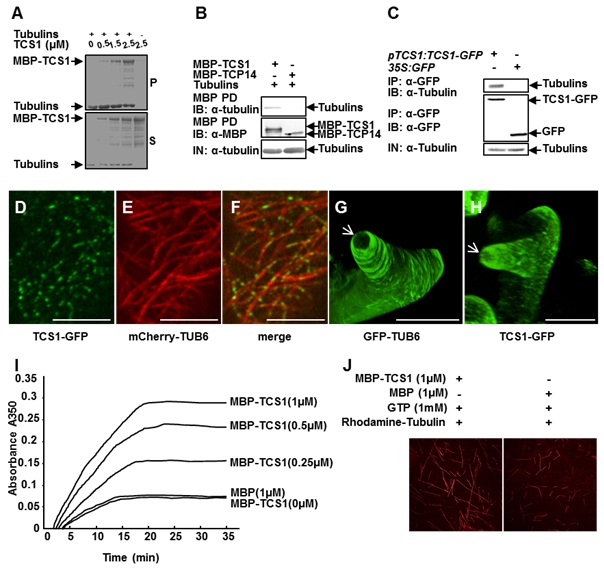PLoS Genetics:中科院遗传所李云海研究组揭示植物细胞大小和形状
2016年10月21日,国际知名学术期刊《PLOS genetics》发表了中国科学院遗传与发育生物学研究所李云海研究组、中国科学院微生物研究所研究员孔照胜以及中国农业大学教授袁明、毛同林实验室合作题为""的研究论文,研究揭示了细胞骨架蛋白TCS1调控细胞大小和形状的新机制。李云海研究组博士生陈亮亮和彭元成为该论文的共同第一作者,李云海研究员为论文通讯作者。
植物细胞的大小和形状对于细胞的生物学功能乃至器官的整体形状及大小具有非常重要的意义。表皮毛作为大部分植物地上部分表皮组织特有的结构,由于其起源和发育简单且易于观察,已成为从单细胞水平研究植物细胞发育的模式。细胞学的研究表明细胞骨架的动力学等参与调控表皮毛的细胞大小和形状,然而其调控的分子遗传机制有待进一步解析。
研究人员以单细胞表皮毛为模式,通过遗传筛选鉴定了表皮毛细胞叉数降低、大小和形状改变的tcs1突变体。TCS1编码了一个新的微管结合蛋白。微管聚合实验表明 TCS1可以促进微管的聚合,参与调节微管的稳定性,从而决定细胞大小和形状。TCS1与微管马达蛋白KCBP直接互作,并作用在同一遗传途径调控细胞的大小和形状。
研究以单细胞表皮毛为模式,发现了一个新的微管结合蛋白TCS1,TCS1与微管马达蛋白KCBP复合体互作,从而调控植物细胞大小和形状的新机制。该研究成果对于解析细胞形态建成的分子遗传机理具有重要的意义。

TCS1通过调控微管的稳定性从而决定细胞大小和形状
原文链接:
TCS1, a Microtubule-Binding Protein, Interacts with KCBP/ZWICHEL to Regulate Trichome Cell Shape in Arabidopsis thaliana
原文摘要:
How cell shape is controlled is a fundamental question in developmental biology, but the genetic and molecular mechanisms that determine cell shape are largely unknown. Arabidopsis trichomes have been used as a good model system to investigate cell shape at the single-cell level. Here we describe the trichome cell shape 1 (tcs1) mutants with the reduced trichome branch number in Arabidopsis. TCS1 encodes a coiled-coil domain-containing protein. Pharmacological analyses and observations of microtubule dynamics show that TCS1 influences the stability of microtubules. Biochemical analyses and live-cell imaging indicate that TCS1 binds to microtubules and promotes the assembly of microtubules. Further results reveal that TCS1 physically associates with KCBP/ZWICHEL, a microtubule motor involved in the regulation of trichome branch number. Genetic analyses indicate that kcbp/zwi is epistatic to tcs1 with respect to trichome branch number. Thus, our findings define a novel genetic and molecular mechanism by which TCS1 interacts with KCBP to regulate trichome cell shape by influencing the stability of microtubules.
doi:10.1371/journal.pgen.1006266
作者:李云海

